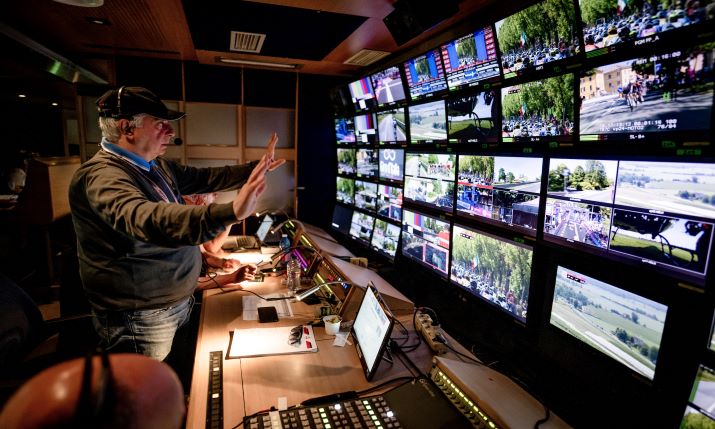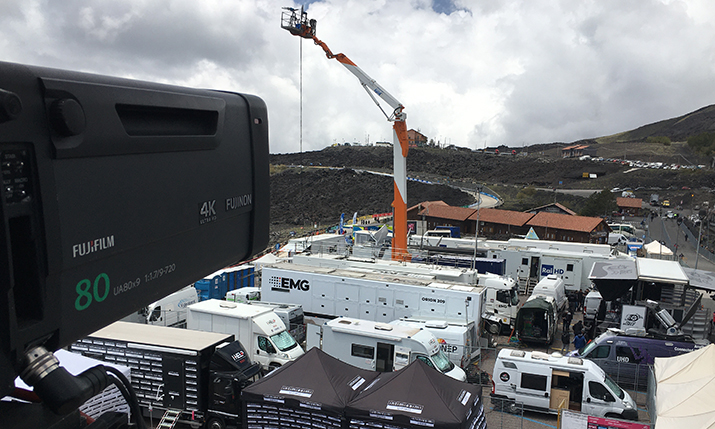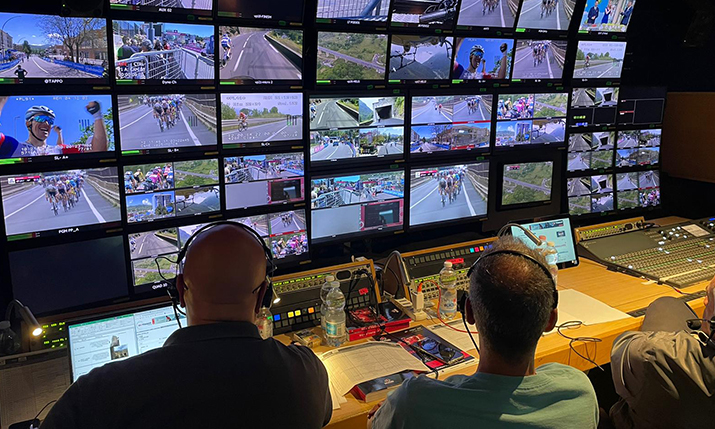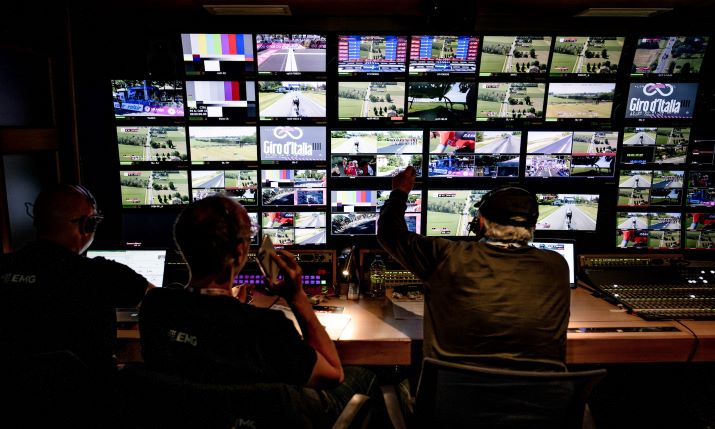EMG combines European forces to bring Giro d’Italia to life
First time that event organiser RCS runs host broadcast operation

Angelo Carosi is the lead director on Giro d’Italia. EMG is utilising its plethora of broadcast technologies and the reach of its expertise across Europe to create an innovative production for RCS’s first Giro d’Italia as host broadcaster
Giro d’Italia 2022 is being televised by EMG for the host broadcaster and event organiser, RCS. This marks the first year that RCS has run the production after taking the role back from Italian public broadcaster Rai which had produced the event for the last 20 years.
As of 2022 EMG is utilising its plethora of broadcast technologies – externally and internally developed – and the reach of its expertise across Europe to create an innovative production that misses nothing, and still hits the budget, to viewers. It plans to further develop its production with more innovations over the course of the three years of its agreement with RCS.
Fabio Guadagnini, EMG Italy chief commercial officer and project leader for Giro d’Italia, tells SVG Europe from his OB van in Italy: “This year [RCS] decided to leave the former relationship they were having with the national broadcaster doing the production [Rai]. They were leaning on Rai for everything that was connected with the TV production. This year, they decided to centralise it and being chosen as their partner for this was for EMG very important.”

EMG has bought together its Italian, French and Belgian divisions to work together on this project for the first time. Shown here, the Mount Etna TV compound
Combined forces
EMG has bought together its Italian, French and Belgian divisions to work together on this project for the first time, combining skills, expertise and technologies to come up with a strong and unique solution for RCS and the Giro.
Guadagnini comments: “The thing that as a group has a very huge meaning is that in this project, we are working with three different countries – Belgium, France and Italy – as a group and a partner for the first time, with the three of us working together for a single project. So it’s another small revolution that we have started from this year.
“Our intention when started with the three year deal [with RCS] is to be connected with RCS for a longer period, and [we are] starting improving the innovations [used in the broadcast]. As a group [we know that] this is just the starting point of the path, [working together as a group on] innovations, and bringing new stories in; this is something we would like to do.”
“We are pushing the content over the mountain. That is one of the biggest challenges. If we are not able to detect the aircrafts while blocked because of high mountain tops, we use an additional team and set up a ‘bounce’ via satellite and several carriers back to the finish”
Adds Guadagnini: “The grand production is essentially something that the Italian entity is leading, because we know the territory – the specific complexity in having a lot of mountain stages – and we have people here. Aerials is something that we are leading in worldwide, thanks to the technology brought by EMG Belgium and EMG France, and also [specialist] knowledge of cycling comes from those countries, where cycling is like what football is in Italy. Putting all of this together as a group was the only way to provide to our partner the best a top class production.”
Chris Demeuleester, EMG Belgium head of international projects and sales, and project leader for Giro d’Italia, says to SVG Europe: “It’s actually even larger [than EMG France, Italy and Belgium]. The uplinks, coordination and the quality control is done in Holland, with satellite trucks we’re going to bring in next year from Holland. This year the OB trucks, the classic business, is coming from Italy. The helicopter coordination is coming from Belgium. The aircraft and the tracking is from the French [division]. So it’s probably one of the biggest projects we [have done] as one solid, glued EMG. Guadagnini is leading for the group and we add in all our specialties and engineers, while Guadagnini coordinates everything, and we execute for Guadagnini ‘s clients. Done deal.”
Continues Demeuleester: “So with the content team and the technology team, we have less people in the team, we are closer to each other, and I think it’s one of the biggest advantages that our clients can see. The storytelling, the engineering, the commercial aspects of this project, the coordination by Guadagnini and his team, is in one smooth, lean and mean package that we can bring to the table. In the past with previous clients, they have looked at us as the technical guys; now we are bringing engineering and content and storytelling, knowhow, and new technologies for the future, because there’s plenty other tools that we will bring [to Giro d’Italia] with Guadagnini and his team.”
Lean and mean
RCS, the biggest race organiser in Italy for a number of sports, has one major Italian client for Giro d’Italia, Rai, and one major external client, Warner Bros. Discovery. On what is being produced, Guadagnini says: “We produce about six hours of live production per day; at least six hours, sometimes more than that because we have to shoot the preparation of the race. We have also the ceremonies, the awards, after the race, so it’s a very extended, long production that we have to do.”
Demeuleester notes that EMG is using its experience on similar races such as the Tour de France to make the coverage work smoothly: “We are lean and mean, we are fast, efficient, and we do this with less people – we are doing this production with 75 crew in total – but what do we do differently? We cover flag to flag with a very, very, very powerful intermediate set up. That’s one of our specialties that we learned during the Tour de France, going into the Alps or the high mountains; it’s totally different than doing a race somewhere in the flat areas of Italy.”
EMG is using five motorbikes, two helicopters, two airplanes, plus five additional motorbikes for Rai and Discovery on this production.
Demeuleester comments on how EMG has managed the production: “I started together with Guadagnini on this project and we do it in basically two blocks. The first block is very basic; it is classic OB coverage. The second block which is probably the most complicated is basically everything that is long range; long range coverage.
Demeuleester continues: “Why is this year a bit more complicated than ever for the Giro d’Italia? The Giro is covered from flag to flag; that means from start of the race to the end it’s live covered on Eurosport on Rai, on all the broadcasters. On a flat race it’s not really an issue because the tools we are using are powerful enough, but the moment we go into a mountain situation, you need relay systems. You need to work in different blocks with different tools, with different teams handing over the signal, literally over the mountain; we are pushing the content over the mountain. That is one of the biggest challenges. If we are not able to detect the aircrafts while blocked because of high mountain tops, we use an additional team and set up a ‘bounce’ via satellite and several carriers back to the finish.
Demeuleester continues: “Our second challenge is everybody’s always focusing on a live feed covered by three or four motorbikes and a helicopter because that’s what everybody sees on the air. But besides that our team is delivering unilateral services for all these other broadcasters. So we are not driving around with four classic TV motorbikes, but we are having 10 motorbikes up and running on the track. That creates massive bandwidth issue that we need massive different lines that we are pushing from point A to point Z.
“Plus a third element, which is very challenging every day, is Guadagnini and his team are at a different location. The trucks are arriving in the evening around midnight. Next day at 10 o’clock they are ready to go live. So every day, a whole circus is being built, moved, installed, tested, set up and ready to go live. There is no moment to make mistakes or errors and that creates a bit of pressure on the people.”

EMG crew hard at work in the OB for this year’s Giro d’Italia
Tech talk
EMG is using huge truck capability to cover this event. While the Giro started this year in Budapest, Hungary for the first three live stages, in less than 24 hours the entire production set up of trucks, RF motorbikes, crew, helicopters and relay aircraft needed to be available at the Mount Etna, Sicily stage to continue the race. Says Demeuleester: “Of course trucks can never be on time, so we used double set ups and double teams.”
EMG has an in-house-developed RF platform, called Livetools, created especially for the complex and high volume transmission of the Giro. Livetools, which has been designed as centralised low-latency wireless solution, is focused on time-based interleaving modulation and automatic ASI switching.
EMG uses interchangeable RF modules for 1310-2000, 1990-2700 and 3400-3800 MHz; changeable bandwidths that gives the crew spectrum flexibility all over the European Union and the rest of the world.
Demeuleester goes on: “What is actually very special in what we do, [which we also do] on the Tour de France, is our antenna tracking system, which is military-based. We are [focused on high] performance in high altitude mountains. Underneath our aircraft and every motorcycle, every source is tracked individually, so if the motorbike drives to the left and the pilot needs to fly to the right by coincidence because of wind and altitude, the antennas will [still] always look to each other. If the pilot banks to the left, the antenna will always follow the exact location [of the helicopter].
“[That gives us] a whole mix of data that we mix in the aircraft and recompile the ASIF stream and we recreate a new signal out of it. So we always pick the best feed from the best motorbike in the best carrier. We push it to the aircraft, we track it back to the compound and there we select [which is the most] stable signal, what is good, what is not good, but very fast of course, and we create a new video stream.
“If you compare it with previous periods, the helicopter pilots were just, let’s say, bus drivers carrying a cameraman. Now what we do up front is we engage the pilots and the Cineflex operator in those places of interest so they become part of the storytelling. That means that everybody in that chain becomes important”
Continues Demeuleester: “So what do we do differently? Well, time-based interleaving modulation with automatic package switching and our high gain antennas in-house; that is really key and core from us. No one in the world has that type of modulation technology because we designed it ourselves. We have our in-house live tools and coding tools, so Rai or BBC or any other broadcaster who would do similar projects, they would always use off the shelf equipment from manufacturing. We don’t think that equipment is good enough for what we do, so we designed our own encoding.
“The high gain antenna tracking concept is probably the strongest tool in this long range RF solution. All individual sources – helicopters and motorbikes – are tracked individually from a B200 King air platform flying at 22,000 to 27,000 feet. These individual controllable antennas (TX/RX) create the RF backbone of the entire system.”
Audio communication for the camera crew is an important part of the EMG set up, says Demeuleester : “Because we do [these type of productions] 180 days a year, we want to create comfort for Guadagnini ‘s team. The intercom is not classic UHF VHF; we created an entire digital link back to the motorbikers. So the motorbikers sitting there on the bike for more than six, seven hours a day, they have a digital intercom line that creates comfort, that creates more attention for the cameraman to the director, and so the director doesn’t need to over-yell. Everybody’s very relaxed and Guadagnini ‘s team can work very professionally in a small and cool environment. It’s like the cameraman are connected with cables. It’s exactly the same functionality.”

EMG is using 10 motorbikes to cover the Giro so nothing is missed
Storytelling creativity
Angelo Carosi is the lead director on Giro d’Italia, with deputy directors Franco Scotton and Antonello Grippo. Guadagnini says the storytelling aspects of an event such as this are focused on showcasing the race, the competition, the country, and all the many other stories going on, both on and off the track. EMG is using two helicopters to enhance this storytelling. One is focused on the race and the other films the landscape, gathering evocative footage of the scenery in relation to the peloton to provide directors with the opportunity to give viewers visual context of where the race is geographically, while also showcasing the splendour of the Italian countryside. In addition, the camera operator onboard the second helicopter captures 360 images in the locale of the race.
Notes Guadagnini: “The complexity of a race like Giro d’Italia is that we have more stories crossing over and very close to each other, so what we do every day, from the following day and what we prepared earlier when we started this race, is to ask ourselves to tell the story of the territory, the country and the sports performance, all mixed together.
He continues: “We are totally aware of the technical value of Giro d’Italia as a race competition, but we are fully aware of the high value that our country in our territory can tell of the passion, the roads and the cities and the villages across the country. We have a daily meeting [from which we create] parallel rundowns. The first one is for what we call the ground production, so the roads and the cameras positioned at the start and at the arrival, together with the story we can tell thanks to our helicopters. These helicopters have their own rundown, to tell how the landscape follows this story, these people, competing in this race. These parallel stories are the main approach that Angelo, Franco and Antonello are calling the cameras from every day in our races.”
Demeuleester comments on the parallel rundown approach: “If you compare it with previous periods, the helicopter pilots were just, let’s say, bus drivers carrying a cameraman. Now what we do up front is we engage the pilots and the Cineflex operator in those places of interest so they become part of the storytelling. That means that everybody in that chain becomes important. In the past the pilot got his briefing the same day of the production. Our pilots have a briefing two months [before the race].”
One of the reasons RCS chose to work with EMG is its ability to offer rights holders personalised feeds. Says Demeuleester: ” Discovery asked us to have a special TV bike equipped with remote minicams in order to cover Sir Bradley Wiggins during his live interviews.
“One of the key storytelling lines for Discovery is Bradley, so for Discovery we created a dedicated Bradley Wiggins feed, so Bradley is on a motorbike and we installed mini cameras that we can switch, so if he’s doing reports and live interviews in the race, on the right side of a rider or on the left side of a rider, we use mini cameras that can pan and tilt, they can zoom in and out; we control that camera. We feed that signal on one of the embedders up to the satellite, up to the truck. We unplug that signal and send it separately to Paris, where we get a return line, because [Bradley] needs to know what’s going on in Paris, of course, and so on. So there is a massive in and out of data and lines and feeds.”
The company is also enhancing the world feed with ‘snackable videos’ and fan perspective shots. Demeuleester explains: “If we are doing a certain climb where a famous rider was very well-known, like Marco Pantani who is a God in Italy, what we would do the morning, very early, we would send one of our ENG EFP media content managers. He will grab and film with a wide sensor camera, some arty [shots] and quotes for content; for instance, extreme close ups of paintings of Marco Pantani on the asphalt, where you can see the emotion of the Italians that will pass by. We will [turn that into] a clip and during the live, [as the riders] head up to that climb, we launch that clip so the viewers at home would already recognise, “oh, that’s the climb coming up”.
“I call these snackable videos that we push into the world feed,” continues Demeuleester. “A second example, is what we do at a classic cycling race is cover it with a minimum of three motorbikes, four is comfortable; but we are using a fifth one at Giro d’Italia. That fifth motorbike will never do the direct storytelling of the race; that fifth motorbike is most of the time used for added content, background filming of the Peloton passing by, but the camera will be not filming the Peloton. It will be filming between the fans, looking from the perspective of the fan at that race, so you bring the viewer’s perspective into reality.”
Concludes lead director, Carosi: “We are lucky because our territory is very, very interesting and we discover each place; I’m Italian but it’s very important for me to discover new places, new adventures, in this country. This is a circus we build every day for one month; the effort is very hard, but [despite] the challenges, [this] is important for us and we are sure of the success of the team.”

